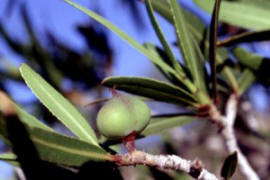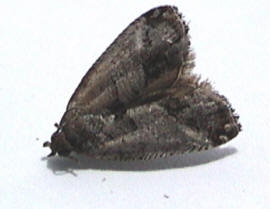Mexican Jumping Beans
I remember the Mexican Jumping Bean craze of my youth. When the bean is abruptly warmed by being held in the palm of the hand, the larva twitches and spasms, pulling on the threads inside the beans and causing the characteristic hop. Recently my boys found them in the store and wanted some, which got us curious about them.
 |
| The ripening capsules of the shrub Sebastiana pavoniana. At this stage, the moth larva is already inside the "bean". source |
Our research uncovered some interesting facts about these fascinating insects. The process starts every Spring when a deciduous shrub native only to Mexico begins to bloom. The shrub is known as Sebastiana pavoniana which grows on rocky desert slopes in the states of Sonora and Chihuahua, Mexico. The female Jumping Bean moth Laspeyresia saltitans lays her eggs on the immature capsules of the shrubs flower. After the moth egg laid on the plant hatches, the larva eats away the inside of the bean (until it becomes hollow) and attaches itself to the inside of the bean with silk-like thread. The capsules that contain the insect larva become hard and changes to a brownish color. The moth larvae, now trapped inside his new home, begins eating the developing seed inside the capsule as food. After the first spring rains occur, the capsules separate into three sections and fall to the ground. The capsules that contain a moth larvae inside begin to "jump" on the forest floor. The larva spasms in an attempt to roll the seed to a cooler environment to avoid dehydration and consequent death. After months of jumping, the moth larvae will go dormant for a short time and begin spinning a cocoon inside the capsule. This is the stage when the larvae will undergo metamorphosis and an adult Jumping Bean moth will emerge.
 |
| source |
The moth will fly off into the desert and this life cycle is repeated for the next generation of Mexican Jumping beans.
Keeping a Mexican Jumping Bean
The tiny moth is harmless to clothes, plants or humans. The moth will only live for a few days and does not eat once it has emerged. Your beans should remain active 3 to 5 months. Don't be upset, however, if the bean stops moving and dies. The majority of the larvae will naturally die inside the bean. This is Mother Natures way of controlling the number of moths in the world and allowing the Jumping bean shrub to continue to grow. Beans do require semi-regular re-hydration, mimicking the monsoon weather of their native Mexico. Once a week lightly mist the beans with lukewarm water. Allow the water to soak into the beans (5 - 10 minutes) and remove any excess water with a paper towel. Drying your beans is very important. Leaving the beans wet may cause mold to grow on them shorting their life expectancy. The chlorine found in tap water in most cities in the US will kill them, so use bottled or filtered water. To prevent accidents such as being sucked up with the vacuum cleaner, always put your Jumping Beans back into their plastic case they usually come in for safe keeping.
sources:


